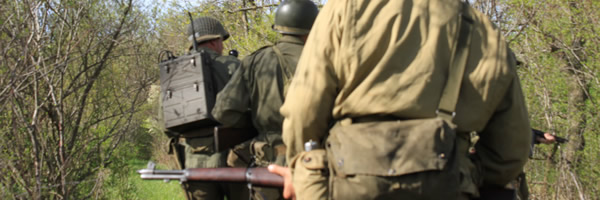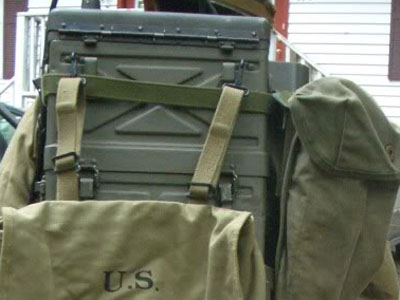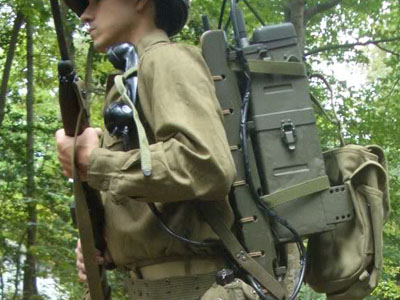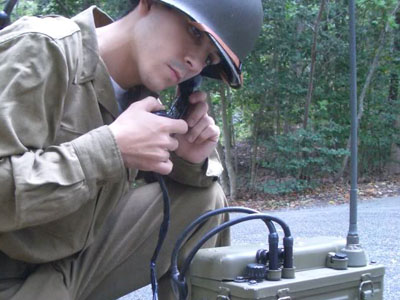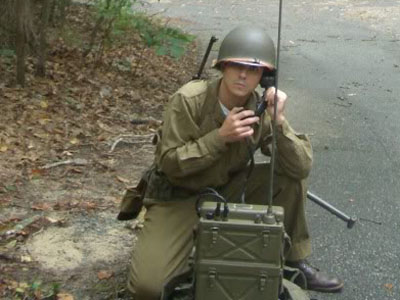Tableau Number 2
The SCR300 Radioman
Date: April 2013
Author: Pat Costa - 88th ID & 5th Rangers Dog Company
90th IDPG Editors - Chris Guska, Lee Mudd, Mike Ellis
Adaptng the SCR-300 for Reenactment use:
Many original SCR-300 radios are fairly complete. These radios can be made to work as originally constructed. Of note, the SCR-300 operates on a FCC regulated frequency, requiring the operator be a licensed HAM.
Modern power supply units are frequently available on eBay from “inverter45”. These modern battery and converter units drop connect to the BC-1000 via the original battery cable.
It is unlikely that any other reenactors will also have a working SCR-300 on original frequencies at a battle event.
The FCC requirements are a non-starter for many reenactors, therefore reenactors gravitate towards the non-regulated Family Radio Service spectrum.
FRS vs CB:
Most reenactors currently use Family Radio Service (FRS) with the What Price Glory SCR-536, or commercial off-the-shelf radios.
It can be expected that at any moderate-sized battle event, other participants will show up with FRS radios.
It is unlikely that chatter from non-partipants will be evident on FRS in battle areas based on their limited operating range. CB radios, on the other hand, may pick up more extraneous communications with their greater range.
The Internal Hookup Method:
There are two basic approaches to utilizing FRS with a SCR-300.
Dave Jeglum wrote a method for "Retrofitting the BC-1000" as published in The Edge, Issue 2, Vol. 19, Apr.-May-Jun. 2010
His article is unfortunatley no longer available on the HRS website.
The External Method of Radio Hook-up:
Another possibility (used by the author) is to buy an external clip-on microphone attachment, tape the external microphone to the handset, use black electrical tape to tape the wires to the phone handset which leads to an FRS radio hidden away in a bag, pocket or clipped to a packboard.
The handset could then be stashed in M1941 pocket, M1943 pocket, a bag, or with straps hooked to a shoulder strap which would bring the phone closer to the mouth and ear rather than stuck in a pocket. In these pictures I demonstrated possible combination of FRS radio hook-up using both the harness system and the packboard system. The pictures are not farb-free as finding correct parts for the SCR-300 is quite the challenge and more costly than an average infantry impression. While no excuses should be given for having an incorrect impression the current SCR-300 configuration is the best I have.
My preference is to use a packboard as it makes facilitating using the FRS radio easier as there is no need to stash into a bag, although, some enterprising radioman reenactor may come up with a better method. In this picture the FRS is clipped behind my shoulder onto the canvas backing. Having it here allows channels to be changed. While it looks like it would fallout during contact it stays relatively stable and secure throughout an event.
External FRS Radio hook-up with a packboard:
Here you can see the radio handset secured to the packboard straps with a basic canvas web strap. Having the handset close to the head makes it easier to talk and hear incoming calls.
Here you see the BG-150 attached to the side of the bag. It is secured through the use of QM quick release straps. Inside the bag I carry rations, socks, and whatever else I may need during the event.
In this picture I have attached a bag to the radio to demonstrate a possible location for a bag to hold extra gear.
In this shot, you can see the handset attached to the harness strap with a canvas strap. Also notice the handset cord running into the BC-1000. What you cannot see is the external handset for an FRS radio as it branches off handset cord into the FRS radio
External FRS radio hook-up with the SCR-300 harness system
The set-up is similar as compared to the packboard with the handset attached to the webbing via a canvas strap.
In this picture you can see the BG-150 has been placed along the side.One issue I seem to have is that the bag tends to get in the way of accessing equipment and ammunition on the pistol belt. I suppose you could better position the equipment on the pistol belt to lessen the BG-150 interference. Another possibility is to take the BG-150 and using rope or a QM strap to secure it to the top part of the BC-1000 as in the packboard example.
This shot you can clearly see the entire handset and attached external microphone. The FRS radio is absent in this example because the possibilities of how to hook-up where to stash the FRS radio is endless. At a reenactment, if I use the harness system, I often leave enough room on the external microphone wires to allow it to connect to an FRS radio stashed in the BG-150, but you might be able to come up with a better method.
On the Ground
One is a close-up and one is a faraway shot with the radio on the ground using the AN-131.
Introduction
Section 1: By the book - TO&E
Section 2: Notes from the manuals on equipment
Section 3: Original Photographs - Key Observations
Section 4: Notes on Training and Use
Section 5: Putting it together- Modern Interpretation
Section 6: Adapting the SCR300 for Reenactment Use (you are here)
Resources
- Combat Lessons 9, 1944
- FM 7-10 Rifle Company, Infantry Regiment
- FM 7-20 Rifle Battalion
- FM 7-24 Communication in the Infantry Division
- FM 24-5 Signal Communication
- FM 24-6 Radio Operators Manual
- FM 24-18 Radio Communication
- Getting the Message Through, A Branch History of the U.S. Army Signal Corps
- TM 11-242 SCR-300-A
Special Thanks
Acknowledgments
Despite calls of fragmentation in this hobby, let this document serve as an example that collaboration and cooperation by units and individuals CAN be done:
The author would like to thank the following individuals for their assistance in editing and correcting this document:
Patrick Cavanaugh, 5th Rangers, OH
Chad Phillips, 33rd Signal Construction Battalion, PA
Richard Killblane, 3rd Infantry Division, VA
Brian Mead, Independent, GA
Bill Grose, Fox Co., 30th Regiment, 3rd Infantry Division, VA
Steve Cooper, 5th Rangers, OH
Jonathan Woosley, 504th Regiment, 82nd Airborne Division, NC
Matt Wiggins, 504th Regiment, 82nd Airborne Division, NC
90th IDPG Original Research



